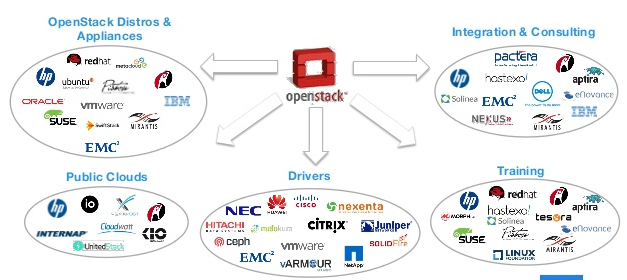OpenStack: How not to “tread on the rake” of OpenSource business
 You have probably heard that a new release of the IaaS platform OpenStack - OpenStack 13 "Mitaka" has recently been released. This is a good reason to write a small analysis-comparison of OpenStack with some earlier project and find out what made OpenStack so successful.
You have probably heard that a new release of the IaaS platform OpenStack - OpenStack 13 "Mitaka" has recently been released. This is a good reason to write a small analysis-comparison of OpenStack with some earlier project and find out what made OpenStack so successful.The idea of this post is in one of my previous translations , where problems were encountered that companies are trying to conduct business on Open Source. More specifically, the head of the XenSource company wrote about problems, and first of all, about the Xen project. There was such a phrase: “If you think that all this is in the past and is no longer relevant, I’ll tell you that I see a similar situation happening today with OpenStack, and this probably happens with many other successful open source projects. "
Let's take a look at what difficulties XenSource wrote to Peter Levine (Peter Levine) and how things are going with it in OpenStack.
')
I will not mention technical difficulties - they are different for each project and, frankly, for some reason I hear about OpenStack technical problems from EMC / VMware representatives . ;-) By the way, if you recall the statements of representatives of VMware, they also carried out analogies between OpenStack and Xen :
Raghu Raghuram, executive vice president of cloud infrastructure and management for VMware, is not so sure of OpenStack. ... The leggame gives an example - not so long ago dozens of companies supported Xen, an open source hypervisor, but in the end almost everyone switched to KVM. ... According to Ragurama, there are two options for the development of events. Either OpenStack, like Linux, will become a recognized standard, or it will go the way of Xen.Of course, Regu Reguram markedly “exaggerates”, not so bad was with Xen in 2012, when I wrote that post, and now even more (about the positive changes that happened with Xen I wrote here ).
But back to the topic of the post. Peter writes, “I'll tell you about other factors that play against“ real ”open source companies.” So, what problems do you have to fear when contacting an Open Source business?
1. Insufficient IT support.
Broad support in the IT industry (I’ll emphasize that among proprietary software vendors as well ) is probably the key to the success of any open source project. Here is what Peter writes:
But if the company does not hire most of the developers of this open source product, then there is a high probability that the project will never be able to gain the desired pace of development.Indeed, Xen has been gaining momentum for quite some time. It is likely that this was due not only to the “youth” of x86-based virtualization technologies, but also to the lack of resources — many companies simply waited for the project to “mature” instead of investing in development.

OpenStack had no problems with this - the project quickly recruited participants who actively developed the project. OpenStack is deservedly called “the fastest growing open source project” - in the figure above, the 2013 data ( and here is the current list of companies ). I want to note that many companies took an active part in OpenStack even before the formation of the OpenStack Foundation. Such wide support, of course, had its reasons, but we will not dwell on them now.
2. "Splitting" of the project.
In the previous paragraph, I wrote that few companies were eager to be included in the Xen project, but even those who did something did not return anything to the main public repository (Upstream). Here is what Peter writes about this:
In addition, the risk is that another company may decide to fork your product.And just below:
The situation is aggravated by the fact that the more successful the open source project is, the more large companies want to manage the code base themselves. I myself faced this when I was the CEO at XenSource - many of the major players in the IT market borrowed our code base, and we did not get any benefit in return.Correct me if I'm wrong, at that time there were two main IT players that specialized on Xen - these are XenSource and VirtualIron (the second was absorbed by Oracle in 2009, and since then the product has not been developed or delivered to customers. )
But besides this, there were Sun xVM products, Oracle VM, and of course Xen as part of Linux distributions, including RHEL and SLES. These companies poorly coordinated the development among themselves, because were direct competitors. And instead of combining development efforts, the dispersion of forces was obtained.
Please note - the main advantage of the Open Source model, which is the ability to combine the resources of companies that employ the best IT industry specialists, did not work in the case of XenSource. Only after the transfer of Xen “under the wing” of LinuxFoundation in 2013, the main public repository (Upstream) appeared, which did not depend on commercial companies, but the valuable time was already lost ...
And what about this in OpenStack? Initially, the OpenStack project also showed signs of a similar problem, but there are two significant differences. The first is that the founders of OpenStack, NASA and Rackspace, did not make money by selling OpenStack software. (Noticed how the platform “ears stick up” that Peter Levine is talking about?). And the second difference is that the OpenStack Foundation was formed in 2012, and this, in my opinion, helped turn companies from competitors into like-minded people.

Look at the picture above, OpenStack does have a lot of different distros (upper left corner). But these are distributions, not forks of the OpenStack project, and this is a very important difference. Although it must be admitted that in terms of making a profit, having a large number of competitors is, of course, a minus - the likelihood that your distribution kit will be chosen decreases many times when companies with a well-known brand, a large history of successful projects and a good sales channel enter the market. Here and among the participants of the OpenStack Foundation there are conflicts on this ground:
Red Hat began working with Mirantis, but the latter never promised to use only RHEL. In June 2014, she announced her collaboration with Canonical, intending to create her own OpenStack distribution based on Ubuntu. Red Hat’s response didn’t take long: Red Hat decided to stop supporting RHEL in the Mirantis OpenStack distribution.
3. Weak controllability development.
This is the “sore point” of all open projects. OpenStack, of course, is not a “small team”, but for OpenStack this factor is just as relevant as for Xen:
And one more argument - for a small distributed team of developers, it is very difficult to determine the line between code stability control and active development.XenSource for quite a long time had problems with including their patches in the main branch of the Linux kernel, which led to the complexity of the installation and upgrade processes. (By the way, this was written in the post-translation comments).
This factor, even more previous was manifested in OpenStack. There was a lot of talk about the fact that OpenStack will destroy his own community and that the problems of managing the platform remain relevant . On Habré there is an excellent article on this topic , I will quote a small piece of it:
Therefore, of course, it's cool to scold OpenStack and say that “something must be done” in order to change the project. But the fact is that OpenStack will pass through this "difficult teenage" period, when it is still clumsy and when the older ones think that "someone should take the boy by the hand." Is it possible to improve the current process? Of course. But the community can do it on their own, without the “dad” (or “mom”) telling him to “tidy up the room”.I think that it was precisely because of these management problems that at one time Citrix’s attitude towards OpenStack changed from full involvement to absolute detachment. And by the way, last week was exactly one year since Citrix returned to active work with OpenStack . But the history of the relationship between Citrix and OpenStack deserves a separate post, someday I will write it .
What other difficulties do open-source companies face?
So, we can conclude that the obstacles that Peter Levine wrote about were more or less eliminated thanks to the creation of the OpenStack Foundation and closer interaction of the companies participating in the project.
I described three obstacles faced by companies trying to run an Open Source business. Perhaps it would be worth adding “Distrust of open source software among the management of customer companies”, but I think this obstacle is already in the past. Or not? How do you think? Write in the comments other difficulties encountered by OpenSource companies, we will discuss. ;-)
Source: https://habr.com/ru/post/282734/
All Articles